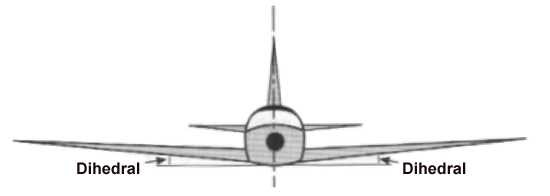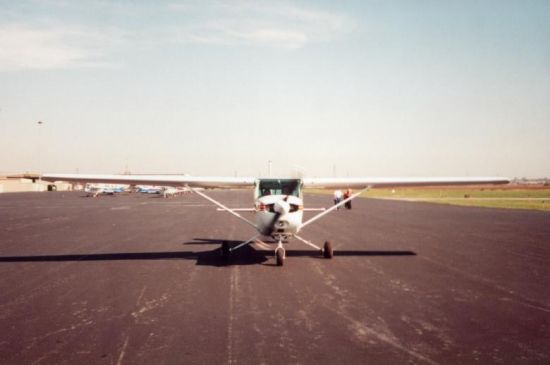|
||||||||||
|
|
||||||||||
|
||||||||||
|
|
||||||||||
First we will cover wing twist, of which there are two kinds, geometric twist and aerodynamic twist. A technical definition of geometric twist would go something like this: "an actual change in the airfoil angle of incidence, usually measured with respect to the root airfoil." (Raymer, Aircraft Design) In other words, if you were to look at a wing from the side, the airfoil (cross section) of the wing would rotate as you moved away from the aircraft fuselage. In most aircraft, the airfoil twists down as we move along the wing further from the fuselage. This is referred to as "washout."

Aerodynamic twist is defined as "the angle between the zero-lift angle of an airfoil and the zero-lift angle of the root airfoil." In essence, this means that the airfoil of the wing would actually change shape as it moved farther away from the fuselage. Typically the zero-lift line is rotated downward toward the wing tips, similar to geometric twist.
Regardless of whether you are talking about geometric or aerodynamic twist, the purpose is the same. Twist is applied to wings so that the outboard section of the wing does not stall first. When an aircraft is pitching nose up and increasing its angle of attack, the airflow over the wing eventually reaches a point where it becomes turbulent, causing a loss in lift. By twisting the outboard portion of the wing down, the stall is delayed in that area, simply because the angle of attack is lower in that region. Why is the outboard portion of the wing so important? It is because that is where the ailerons are located. By maintaining lift on the outboard portion of the wing, the pilot is still able to maintain roll control of the aircraft in the event of a stall. A good example of wing twist can be seen in the F-18 Hornet as illustrated here.
Now let's talk about dihedral. Much like twist, there is an actual geometric dihedral, and an effective dihedral.
First we will talk about dihedral. Dihedral is the upward angle of the wing from the vertical when seen from the front, or nose of the aircraft. If each wing is angled 5° up from the horizontal, then the wing is said to have 5° of dihedral. A good example of geometric dihedral can be seen on the P-3 Orion shown here. The opposite of dihedral is called anhedral, and, of course, refers to a wing that is angled down. A good example of an aircraft with geometric anhedral is the Sea Harrier exemplified here.

Effective dihedral is pretty much what it sounds like. Effective dihedral is the effect of other aspects of the aircraft configuration that produce an effect similar to geometric dihedral. Many aspects of an aircraft's configuration can effect its effective dihedral, but two major components are wing sweep and the wing location with respect to the fuselage (such as a low wing or high wing). As a rough estimation, 10° of sweepback on a wing provides about 1° of effective dihedral, while a high wing configuration can provide about 5° of effective dihedral over a low wing configuration.
All this talk of anhedral and dihedral leads to the question of why one would want use either of these on an aircraft. The simple answer is they provide lateral (roll) stability. Let's consider an aircraft rolling to the right. As it does so, the right wing produces more lift than left wing, causing the rolling motion. At the same time, however, this increased lift creates an increased drag, which causes the aircraft to yaw to the left, an effect known as adverse yaw. This is why pilots need to apply rudder in the direction of the turn.
Now let's consider the advantages of dihedral. When an aircraft with dihedral is yawing to the left, the dihedral causes the left wing to experience a greater angle of attack, which increases lift. This increased lift tends to cause the aircraft to then return to level flight. I know this is very confusing in words, but if you stick your arms out in the air and recreate all of these motions, it should make sense. Sometimes it helps to only consider the yaw, and ignore the roll. The end result of all of this is that dihedral tends to make an aircraft more stable. For some aircraft, like fighters, stability really isn't a good thing. A slight instability in an aircraft lends to increased maneuverability, which is highly desirable in fighter and attack aircraft. This is why most aerobatic planes and military fighters utilize some amount of anhedral.
The observant aerophile will also notice that most large transports, such as the C-5 Galaxy and Antonov An-225, have noticeable anhedral, but are far from what anyone would consider "maneuverable" (nor do they need to be). Indeed, these aircraft are laterally stable. In fact, the anhedral is required to keep the aircraft from becoming too stable! Recall the earlier discussion on how wing sweep and wing location can affect the effective dihedral. Large transports have both a high wing and a considerable amount of wing sweep, both of which create a large amount of effective dihedral. To counteract this large amount of dihedral, some geometric anhedral is required. Otherwise the aircraft would be overly stable, making turns extremely difficult, and an aircraft that can only fly in one direction isn't much use to anyone.

So to sum up this discussion, the above photo illustrates a forward view of a Cessna 152 and clearly shows
the type's small amount of wing dihedral, which we believe is what the questioner refers to as the wing "twisting
upward."
- answer by Doug Jackson, 2 December 2001
Related Topics:
Read More Articles:


|
Aircraft | Design | Ask Us | Shop | Search |

|
|
| About Us | Contact Us | Copyright © 1997-2023 | |||
|
|
|||